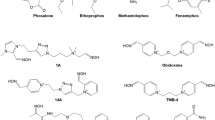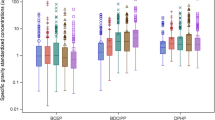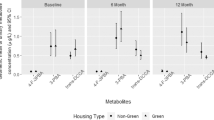Abstract
Exposure to organophosphate and carbamate pesticides can lead to neurotoxic effects through inhibition of cholinesterase enzymes. The paraoxonase (PON1) enzyme can detoxify oxon derivatives of some organophosphates. Lower PON1, acetylcholinesterase, and butyrylcholinesterase activities have been reported in newborns relative to adults, suggesting increased susceptibility to organophosphate exposure in young children. We determined PON1, acetylcholinesterase, and butyrylcholinesterase activities in Mexican–American mothers and their 9-year-old children (n=202 pairs) living in an agricultural community. We used Wilcoxon signed-rank tests to compare enzymatic activities among mothers and their children, and analysis of variance to identify factors associated with enzyme activities. Substrate-specific PON1 activities were slightly lower in children than their mothers; however, these differences were only statistically significant for the paraoxon substrate. We observed significantly lower acetylcholinesterase but higher butyrylcholinesterase levels in children compared with their mothers. Mean butyrylcholinesterase levels were strongly associated with child obesity status (body mass index Z scores >95%). We observed highly significant correlations among mother-child pairs for each of the enzymatic activities analyzed; however, PON1 activities did not correlate with acetylcholinesterase or butyrylcholinesterase activities. Our findings suggest that by age 9 years, PON1 activities approach adult levels, and host factors including sex and obesity may affect key enzymes involved in pesticide metabolism.
This is a preview of subscription content, access via your institution
Access options
Subscribe to this journal
Receive 6 print issues and online access
$259.00 per year
only $43.17 per issue
Buy this article
- Purchase on Springer Link
- Instant access to full article PDF
Prices may be subject to local taxes which are calculated during checkout


Similar content being viewed by others
References
CDPR. 2011 (California Department of Pesticide Regulation) Pesticide Use Reporting Data for 2009. California Pesticide Information Portal. Available: http://calpip.cdpr.ca.gov/main.cfm(Accessed 18 July 2011). 1974.
Adgate J.L., Barr D.B., Clayton C.A., Eberly L.E., Freeman N.C., and Lioy P.J., et al. Measurement of children's exposure to pesticides: analysis of urinary metabolite levels in a probability-based sample. Environ Health Perspect 2001: 109 (6): 583–590.
Bradman A., Barr D.B., Claus Henn B.G., Drumheller T., Curry C., and Eskenazi B. Measurement of pesticides and other toxicants in amniotic fluid as a potential biomarker of prenatal exposure: a validation study. Environ Health Perspect 2003: 111 (14): 1779–1782.
Lu C., Fenske R.A., Simcox N.J., and Kalman D. Pesticide exposure of children in an agricultural community: evidence of household proximity to farmland and take home exposure pathways. Environ Res 2000: 84 (3): 290–302.
McCauley L.A., Lasarev M.R., Higgins G., Rothlein J., Muniz J., and Ebbert C., et al. Work characteristics and pesticide exposures among migrant agricultural families: a community-based research approach. Environ Health Perspect 2001: 109 (5): 533–538.
O’Rourke M.K., Lizardi P.S., Rogan S.P., Freeman N.C., Aguirre A., and Saint C.G. Pesticide exposure and creatinine variation among young children. J Expo Anal Environ Epidemiol 2000: 10 (6 Pt 2): 672–681.
Beamer P.I., Canales R.A., Bradman A., and Leckie J.O. Farmworker children's residential non-dietary exposure estimates from micro-level activity time series. Environ Int 2009: 35 (8): 1202–1209.
Moya J., Bearer C.F., and Etzel R.A. Children's behavior and physiology and how it affects exposure to environmental contaminants. Pediatrics 2004: 113 (4 Suppl): 996–1006.
Ginsberg G., Hattis D., and Sonawane B. Incorporating pharmacokinetic differences between children and adults in assessing children's risks to environmental toxicants. Toxicol Appl Pharmacol 2004: 198 (2): 164–183.
Campbell C.G., Seidler F.J., and Slotkin T.A. Chlorpyrifos interferes with cell development in rat brain regions. Brain Res Bull 1997: 43 (2): 179–189.
Eskenazi B., Bradman A., and Castorina R. Exposures of children to organophosphate pesticides and their potential adverse health effects. Environ Health Perspect 1999: 107 (Suppl 3): 409–419.
Bouchard M.F., Chevrier J., Harley K.G., Kogut K., Vedar M., and Calderon N., et al. Prenatal exposure to organophosphate pesticides and IQ in 7-year old children. Environ Health Perspect 2011: 119 (8): 1189–1195.
Engel S.M., Wetmur J., Chen J., Zhu C., Barr D.B., and Canfield R.L., et al. Prenatal exposure to organophosphates, paraoxonase 1, and cognitive development in childhood. Environ Health Perspect 2011: 119 (8): 1182–1188.
Marks A.R., Harley K., Bradman A., Kogut K., Barr D.B., and Johnson C., et al. Organophosphate pesticide exposure and attention in young Mexican-American children: the CHAMACOS study. Environ Health Perspect 2011: 118 (12): 1768–1774.
Rauh V., Arunajadai S., Horton M., Perera F., Hoepner L., and Barr D.B., et al. 7-year neurodevelopmental scores and prenatal exposure to chlorpyrifos, a common agricultural pesticide. Environ Health Perspect 2011: 119 (8): 1196–1201.
Cole T.B., Jampsa R.L., Walter B.J., Arndt T.L., Richter R.J., and Shih D.M., et al. Expression of human paraoxonase (PON1) during development. Pharmacogenetics 2003: 13 (6): 357–364.
Eskenazi B., Harley K., Bradman A., Weltzien E., Jewell N.P., and Barr D.B., et al. Association of in utero organophosphate pesticide exposure and fetal growth and length of gestation in an agricultural population. Environ Health Perspect 2004: 112 (10): 1116–1124.
Chambers J.E., Meek E.C., and Ross M. The metabolic activation and detoxification of anticholinesterase insecticides. In: Satoh T., and Gupta R.C. (eds). Anticholinesterase Pesticides: Metabolism, Neurotoxicity, and Epidemiology 1st edn. John Wiley and Sons: Hoboken, NJ, 2011, pp. 77–84.
Kobayashi H., Yuyama A., and Chiba K. Cholinergic system of brain tissue in rats poisoned with the organophosphate, 0,0-dimethyl 0-(2,2-dichlorovinyl) phosphate. Toxicol Appl Pharmacol 1986: 82 (1): 32–39.
Kobayashi H., Yuyama A., Ohkawa T., and Kajita T. Effect of single or chronic injection with a carbamate, propoxur, on the brain cholinergic system and behavior of mice. Jpn J Pharmacol 1988: 47 (1): 21–27.
Robitzki A., Mack A., Hoppe U., Chatonnet A., and Layer P.G. Regulation of cholinesterase gene expression affects neuronal differentiation as revealed by transfection studies on reaggregating embryonic chicken retinal cells. Eur J Neurosci 1997: 9 (11): 2394–2405.
Willbold E., and Layer P.G. Butyrylcholinesterase regulates laminar retinogenesis of the chick embryo in vitro. Eur J Cell Biol 1994: 64 (1): 192–199.
Layer P.G., Allebrandt K., Andermann P., Bodur E., Boopathy R., and Bytyqi A.H., et al. On the multifunctionality of cholinesterases. Chem Biol Interact 2005: 157-158: 37–41.
Martos E.R, Ruz R.F.J., Valle J.M., Gascon L.F., Bermudo G.F., and Canete E.R. [High levels of alanine aminotransferase and cholinesterase in obese pre-pubertal children: correlation with basal insulin concentration and anthropometric measures]. An Esp Pediatr 2000: 53 (4): 330–334.
Duysen E.G., Li B., Xie W., Schopfer L.M., Anderson R.S., and Broomfield C.A., et al. Evidence for nonacetylcholinesterase targets of organophosphorous nerve agent: supersensitivity of acetylcholinesterase knockout mouse to VX lethality. J Pharmacol Exp Ther 2001: 299 (2): 528–535.
Li B., Stribley J.A., Ticu A., Xie W., Schopfer L.M., and Hammond P., et al. Abundant tissue butyrylcholinesterase and its possible function in the acetylcholinesterase knockout mouse. J Neurochem 2000: 75 (3): 1320–1331.
Raveh L., Grunwald J., Marcus D., Papier Y., Cohen E., and Ashani Y. Human butyrylcholinesterase as a general prophylactic antidote for nerve agent toxicity. In vitro and in vivo quantitative characterization. Biochem Pharmacol 1993: 45 (12): 2465–2474.
Masson P., and Lockridge O. Butyrylcholinesterase for protection from organophosphorus poisons: catalytic complexities and hysteretic behavior. Arch Biochem Biophys 2010: 494 (2): 107–120.
Timchalk C. Biomonitoring of pesticides: pharmacokinetics of organophosphorous and carbamate insecticides. In: Satoh T., and Gupta R.C. (eds). Anticholinesterase Pesticides: Metabolism, Neurotoxicity, and Epidemiology 1st edn. John Wiley and Sons: Hoboken, NJ, 2011, pp. 267–287.
Camps J., Marsillach J., and Joven J. The paraoxonases: role in human diseases and methodological difficulties in measurement. Crit Rev Clin Lab Sci 2009: 46 (2): 83–106.
Costa L.G., and Furlong C.E. Paraoxonase 1: structure, function, and polymorphisms. In: Satoh T., and Gupta R.C. (eds). Anticholinesterase Pesticides: Metabolism, Neurotoxicity, and Epidemiology 1st edn. John Wiley and Sons: Hoboken, NJ, 2011 pp. 85–95.
Harley K.G., Huen K., Schall R.A., Holland N.T., Bradman A., and Barr D.B., et al. Association of organophosphate pesticide exposure and paraoxonase with birth outcome in Mexican-American women. PLoS One 2011: 6 (8): e23923.
Araoud M., Neffeti F., Douki W., Najjar M.F., and Kenani A. Paraoxonase 1 correlates with butyrylcholinesterase and gamma glutamyl transferase in workers chronically exposed to pesticides. J Occup Health 2010: 52 (6): 383–388.
Benmoyal-Segal L., Vander T., Shifman S., Bryk B., Ebstein R.P., and Marcus E.L., et al. Acetylcholinesterase/paraoxonase interactions increase the risk of insecticide-induced Parkinson's disease. FASEB J 2005: 19 (3): 452–454.
Bryk B., BenMoyal-Segal L., Podoly E., Livnah O., Eisenkraft A., and Luria S., et al. Inherited and acquired interactions between ACHE and PON1 polymorphisms modulate plasma acetylcholinesterase and paraoxonase activities. J Neurochem 2005: 92 (5): 1216–1227.
Hofmann J.N., Keifer M.C., Furlong C.E., De Roos A.J., Farin F.M., and Fenske R.A., et al. Serum cholinesterase inhibition in relation to paraoxonase-1 (PON1) status among organophosphate-exposed agricultural pesticide handlers. Environ Health Perspect 2009: 117 (9): 1402–1408.
Bradman A., Castorina R., Barr D.B., Chevrier J., Harnly M.E., and Eisen E.A., et al. Determinants of organophosphorus pesticide urinary metabolite levels in young children living in an agricultural community. Int J Environ Res Public Health 2011: 8 (4): 1061–1083.
Holland N., Furlong C., Bastaki M., Richter R., Bradman A., and Huen K., et al. Paraoxonase polymorphisms, haplotypes, and enzyme activity in Latino mothers and newborns. Environ Health Perspect 2006: 114 (7): 985–991.
Huen K., Barcellos L., Beckman K., Rose S., Eskenazi B., and Holland N. Effects of PON polymorphisms and haplotypes on molecular phenotype in Mexican-American mothers and children. Environ Mol Mutagen 2010a: 52 (2): 105–116.
Eskenazi B., Mocarelli P., Warner M., Chee W.Y., Gerthoux P.M., and Samuels S., et al. Maternal serum dioxin levels and birth outcomes in women of Seveso, Italy. Environ Health Perspect 2003: 111 (7): 947–953.
National Center for Health Statistics.. CDC Growth Charts. National Center for Health Statistics: United States, 2005.
Huen K., Richter R., Furlong C., Eskenazi B., and Holland N. Validation of PON1 enzyme activity assays for longitudinal studies. Clin Chim Acta 2009: 402 (1-2): 67–74.
Furlong C.E., Holland N., Richter R.J., Bradman A., Ho A., and Eskenazi B. PON1 status of farmworker mothers and children as a predictor of organophosphate sensitivity. Pharmacogenet Genomics 2006: 16 (3): 183–190.
Connelly P.W., Maguire G.F., Picardo C.M., Teiber J.F., and Draganov D. Development of an immunoblot assay with infrared fluorescence to quantify paraoxonase 1 in serum and plasma. J Lipid Res 2008: 49 (1): 245–250.
Kujiraoka T., Oka T., Ishihara M., Egashira T., Fujioka T., and Saito E., et al. A sandwich enzyme-linked immunosorbent assay for human serum paraoxonase concentration. J Lipid Res 2000: 41 (8): 1358–1363.
Wilson B.W., Henderson J.D., Ramirez A., and O’Malley M.A. Standardization of clinical cholinesterase measurements. Int J Toxicol 2002: 21 (5): 385–388.
Ellman G.L., Courtney K.D., Andres Jr V., and Feather-Stone R.M. A new and rapid colorimetric determination of acetylcholinesterase activity. Biochem Pharmacol 1961: 7: 88–95.
Huen K., Harley K., Bradman A., Eskenazi B., and Holland N. Longitudinal changes in PON1 enzymatic activities in Mexican-American mothers and children with different genotypes and haplotypes. Toxicol Appl Pharmacol 2010b: 244 (2): 181–189.
Burman D. Red cell cholinesterase in infancy and childhood. Arch Dis Child 1961: 36: 362–365.
de Peyster A., Willis W.O., and Liebhaber M. Cholinesterase activity in pregnant women and newborns. J Toxicol Clin Toxicol 1994: 32 (6): 683–696.
Clark Jr L.C., and Beck E. The acetylcholinesterase activity of erythrocytes of growing children. Child Dev 1950: 21 (3): 163–167.
Hutchinson A.O., and Widdowson E.M. Cholinesterase activities in the serum of healthy British children. Nature 1952: 169 (4294): 284–285.
Simpson N.E., and Kalow W. Serum cholinesterase levels in families and twins. Am J Hum Genet 1963: 15: 280–287.
McCance R.A., Hutchinson A.O., Dean R.F., and Jones P.E.H. The cholinesterase activity of the serum on newborn animals, and of colostrum. Biochem J 1949: 45 (4): 493–496.
Sperling L.E., Steinert G., Boutter J., Landgraf D., Hescheler J., and Pollet D., et al. Characterisation of cholinesterase expression during murine embryonic stem cell differentiation. Chem Biol Interact 2008: 175 (1-3): 156–160.
Rosas L.G., Guendelman S., Harley K., Fernald L.C., Neufeld L., and Mejia F., et al. Factors associated with overweight and obesity among children of Mexican descent: results of a binational study. J Immigr Minor Health/Center for Minority Public Health 2011: 13 (1): 169–180.
Iwasaki T., Yoneda M., Nakajima A., and Terauchi Y. Serum butyrylcholinesterase is strongly associated with adiposity, the serum lipid profile and insulin resistance. Intern Med 2007: 46 (19): 1633–1639.
Chu M.I., Fontaine P., Kutty K.M., Murphy D., and Redheendran R. Cholinesterase in serum and low density lipoprotein of hyperlipidemic patients. Clin Chim Acta 1978: 85 (1): 55–59.
Inacio Lunkes G., Stefanello F., Sausen Lunkes D., Maria Morsch V., Schetinger M.R., and Goncalves J.F. Serum cholinesterase activity in diabetes and associated pathologies. Diabetes Res Clin Pract 2006: 72 (1): 28–32.
Kutty K.M., Jain R., Huang S., and Kean K. Serum pseudocholinesterase: high density lipoprotein cholesterol ratio as an index of risk for cardiovascular disease. Clin Chim Acta 1981: 115 (1): 55–61.
Alcantara V.M., Oliveira L.C., Rea R.R., Suplicy H.L., and Chautard-Freire-Maia E.A. Butyrylcholinesterase activity and metabolic syndrome in obese patients. Clin Chem Lab Med 2005: 43 (3): 285–288.
Annapurna V., Senciall I., Davis A.J., and Kutty K.M. Relationship between serum pseudocholinesterase and triglycerides in experimentally induced diabetes mellitus in rats. Diabetologia 1991: 34 (5): 320–324.
Li B., Duysen E.G., and Lockridge O. The butyrylcholinesterase knockout mouse is obese on a high-fat diet. Chem Biol Interact 2008: 175 (1-3): 88–91.
Waterlow J.C. Enzyme changes in malnutrition. J Clin Pathol Suppl (Assoc Clin Pathol) 1970: 4: 75–79.
Slotkin T.A. Does early-life exposure to organophosphate insecticides lead to prediabetes and obesity? Reprod Toxicol 2010: 31 (3): 297–301.
De Vriese C., Gregoire F., Lema-Kisoka R., Waelbroeck M., Robberecht P., and Delporte C. Ghrelin degradation by serum and tissue homogenates: identification of the cleavage sites. Endocrinology 2004: 145 (11): 4997–5005.
De Vriese C., Hacquebard M., Gregoire F., Carpentier Y., and Delporte C. Ghrelin interacts with human plasma lipoproteins. Endocrinology 2007: 148 (5): 2355–2362.
Shanado Y., Kometani M., Uchiyama H., Koizumi S., and Teno N. Lysophospholipase I identified as a ghrelin deacylation enzyme in rat stomach. Biochem Biophys Res Commun 2004: 325 (4): 1487–1494.
Bradman A., Eskenazi B., Barr D.B., Bravo R., Castorina R., and Chevrier J., et al. Organophosphate urinary metabolite levels during pregnancy and after delivery in women living in an agricultural community. Environ Health Perspect 2005: 113 (12): 1802–1807.
Acknowledgements
We gratefully acknowledge the CHAMACOS staff, community partners, and especially the CHAMACOS participants. We thank Justin Dittmeier for assisting with cholinesterase activity measurements. This work was supported by grants from the US Environmental Protection Agency (R826886, R82670901) and the National Institute of Environmental Health Science (R01ESO12503, PO1 ES009605). The contents of this paper are solely the responsibility of the authors and do not necessarily represent the official views of the NIEHS and the EPA.
Author information
Authors and Affiliations
Corresponding author
Ethics declarations
Competing interests
The authors declare no conflict of interest.
Additional information
Supplementary Information accompanies the paper on the Journal of Exposure Science and Environmental Epidemiology website
Supplementary information
Rights and permissions
About this article
Cite this article
Gonzalez, V., Huen, K., Venkat, S. et al. Cholinesterase and paraoxonase (PON1) enzyme activities in Mexican–American mothers and children from an agricultural community. J Expo Sci Environ Epidemiol 22, 641–648 (2012). https://doi.org/10.1038/jes.2012.61
Received:
Accepted:
Published:
Issue Date:
DOI: https://doi.org/10.1038/jes.2012.61
Keywords
This article is cited by
-
Children Environmentally Exposed to Agrochemicals in Rural Areas Present Changes in Oxidative Status and DNA Damage
Biological Trace Element Research (2022)
-
Blood cholinesterase activity levels of farmers in winter and hot season of Mae Taeng District, Chiang Mai Province, Thailand
Environmental Science and Pollution Research (2018)
-
Environmental exposure and effects on health of children from a tobacco-producing region
Environmental Science and Pollution Research (2017)
-
Association between paraoxonase 1 (PON1) enzyme activity, PON1 C(−107)T polymorphism, nutritional status, and lipid profile in children
Nutrire (2016)
-
Variability in the take-home pathway: Farmworkers and non-farmworkers and their children
Journal of Exposure Science & Environmental Epidemiology (2014)



